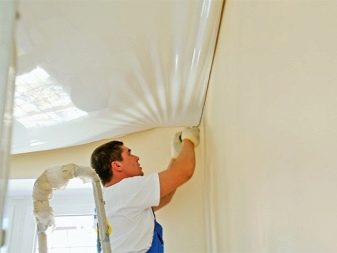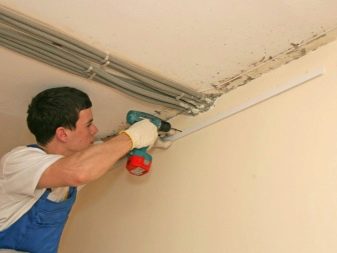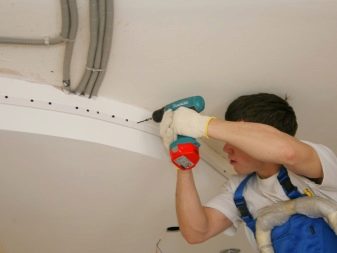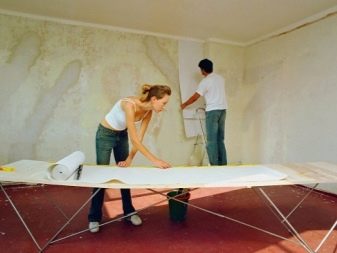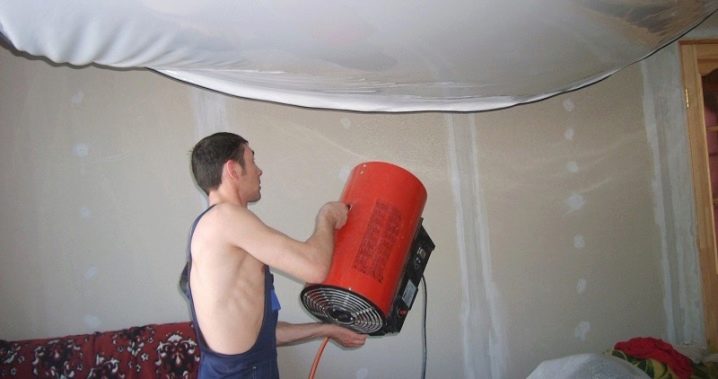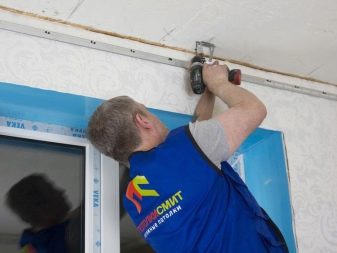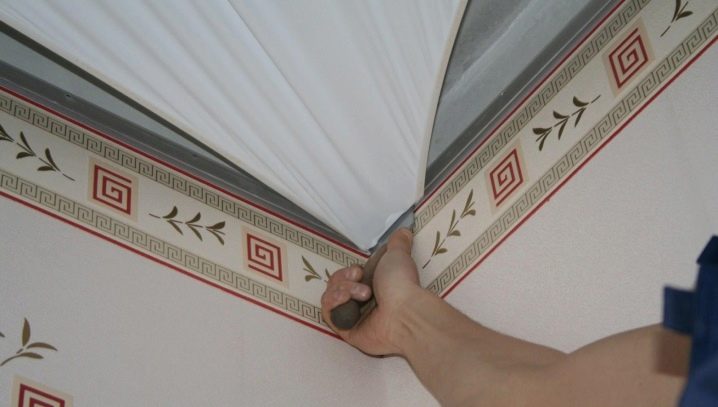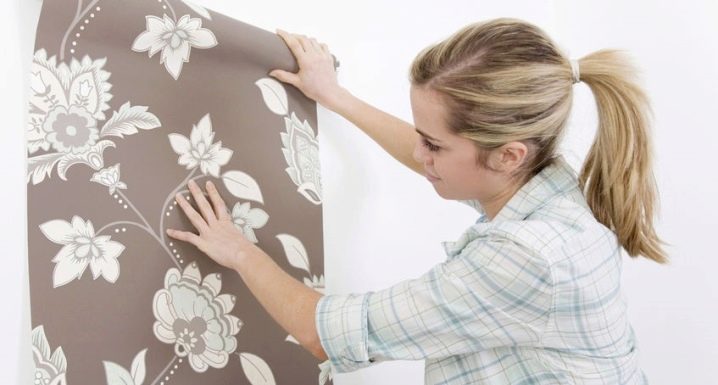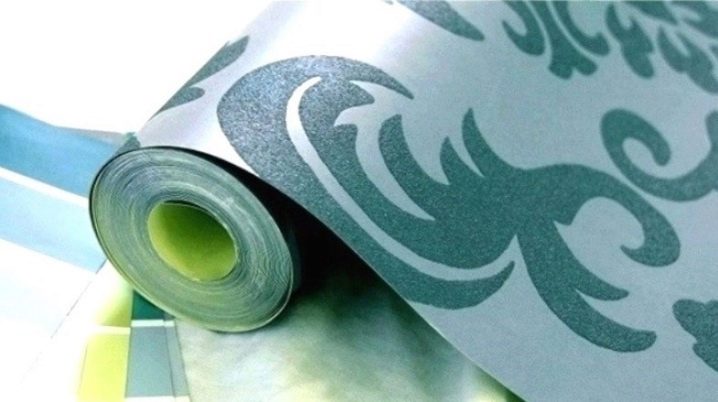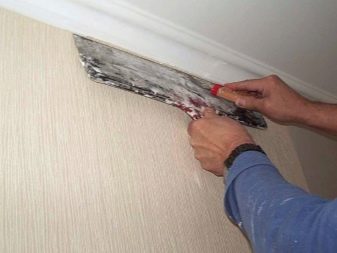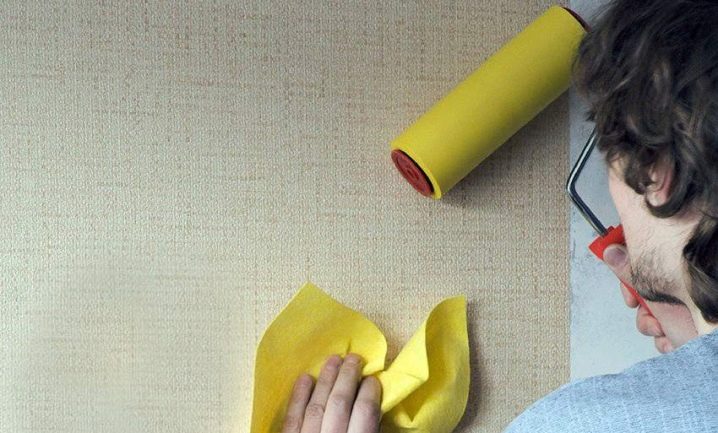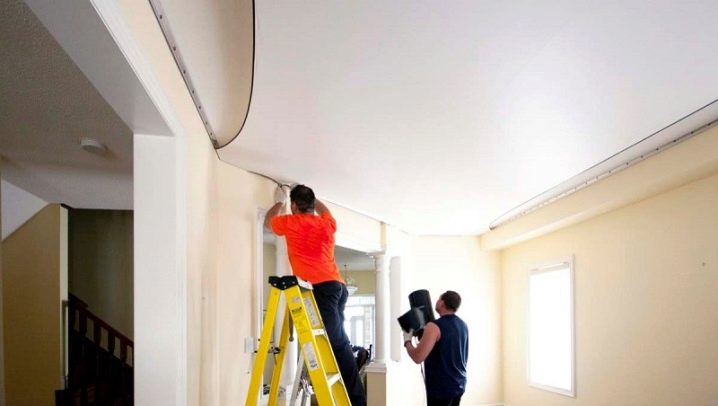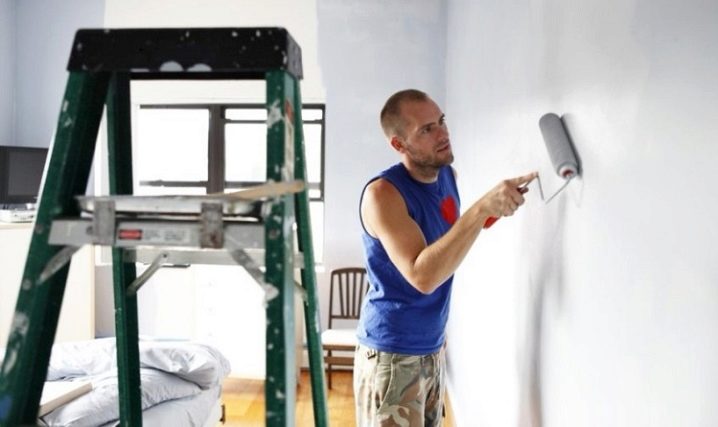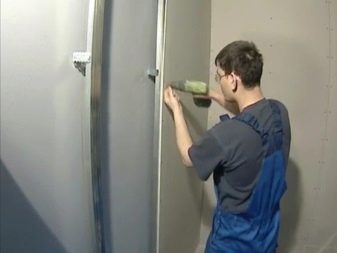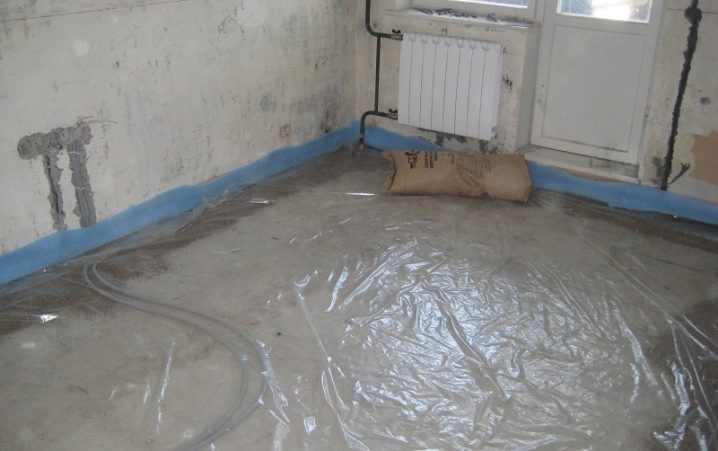What to do first - to install suspended ceilings or wallpaper glue?
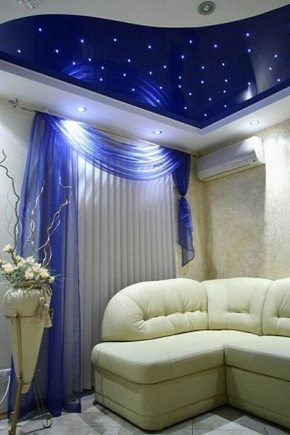
Stretch ceilings have become part of our lives. Every person who is planning a repair in his house, resorts to updating the ceiling. In the process of finishing, it is interesting to many, what is first done - are the ceilings being pulled or are the wallpapers glued?
Mounting methods
Opinions on this account are categorically divergent. To make it easier to determine the choice, it is necessary to study the methods of installation and the device itself stretch ceiling.
There are two ways to install stretch ceiling:
- Harpoon. It will need to pre-measure the area of the room to make a canvas of the desired size.After that, the experts will install a baguette in special nails, which are driven into the walls. This design takes about four centimeters from the walls. The tension cover is heated by the impact of a heat gun and stretches over the entire area. At the end, the material simply snaps;
- No charcoal In it, the canvas is subjected to tight clamping, like a fabric on the hoop. This option refers to a lighter and cheaper, because for its execution is not required to make a preliminary measurement of the room and make the canvas for the specified parameters.
The disadvantage is the possibility of sagging material.
There are fabric stretch fabric. Such material minimizes the risk of sagging, as the fabric is characterized by increased density. Installation of the structure is carried out without heating. At the moment, fabric stretch ceiling with artistic painting is popular.
The first - the walls
Many people decide to glue the wallpaper first, and then begin to choose a stretch ceiling. This option is suitable for beginners.
If you worry that after installing the stretch ceiling walls get dirty, use the ruleswhich will help to avoid a similar situation:
- Before installation of stretch ceilings should prepare the wall. First, make a hole in which the profile or baguette will be attached. In the future, you will need to hang the ceiling sheet itself. Such openings have no effect on the actual decoration of the room, as they will be hidden under the baguette.
- Do not be afraid of ruining wallpaper with high temperatures.. Despite the fact that the ceiling is heated with the help of special equipment to a temperature of 80 degrees, for paper wallpaper this figure is not dangerous. Vinyl and liquid wallpaper are also not afraid of such effects.
- Wallpapering should be made on the prepared walls.s. Align the surface before gluing so that the repairs made are of high quality.
- You can not direct the flame of the gun on the wall. This rule should be familiar to every master.
- Tension cloth can not be installed immediately after gluing wallpaper. Wait at least three days. This time will be enough for the glue to dry and the wallpaper to sit on the surface of the walls. If you neglect this rule,in places of contact with high temperatures, your pasting of walls will begin to depart.
Many people glue wallpaper before stretching the stretch ceiling. They do not see any difficulties in this and report that this technique is very convenient.
For starters - the ceiling
This method is used by professional masters. Installing the stretch fabric before wallpapering gives you the opportunity not to worry about construction waste that can stain the surface of the walls.
If you decide to mount a suspended ceiling yourself, consider the following nuances.
- First of all, you will need to fasten a baguette on the walls. For this purpose, you will need a punch;
- Then you need to warm up the PVC for the stretch fabric. The exposure temperature is 100 degrees. On sale there are fabric cloths. This type of ceiling minimizes the risk of damage to walls and wallpaper.
- The ceiling is secured in a baguette with spatulas. If you wish, you can use a fillet. She hides the gaps that remain between the baguette and the walls. Remember that the fillet can not be glued between the wallpaper, as the coating will lose its appeal.
- So that the finished suspended ceiling does not deteriorate when wallpapering and does not get stained with a primer, fasten the baguette first and then glue the wallpaper to the profile and fix the ceiling. This method will allow you to keep the tension fabric clean.
- If you carry out wallpapering yourself, use masking tape. If the ceiling is soiled with glue, promptly eliminate contamination with a damp cloth.
- If you chose the way in which you must first install a suspended ceiling, and then paint the walls, give up this idea. You can install a baguette, but the canvas itself is usually pulled after the walls are decorated.
- Stick wallpaper as carefully as possible, regardless of whether you have chosen a suspended or suspended ceiling. Exclude blade contact with the knife when cutting wallpaper.
Also, people who have decided to upgrade their rooms when changing wallpapers apply to this method. As a rule, plywood is carried out every five years, and the suspended ceiling will last at least 10 years.
Since updating walls in a pair with a ceiling is rather expensive, most people decide to simply replace the wallpaper without touching the ceiling.
Advantages and disadvantages of each method
To determine which method will suit you best, you should consider in more detail the advantages and disadvantages of each method.
If you decide to pull the tension fabric forward, pay attention to the following advantages.
- Pay attention to the wall material. If red bricks were used in your house during construction, when drilling walls you will encounter red dust that will smudge the walls. For light wallpaper, this "communication" may be the last. When the repair is done by professionals, they keep the nozzle of the vacuum cleaner under the perforator to eliminate the contamination of the walls. Remove concrete or wood dust with a soft brush or vacuum cleaner.
- Stretch ceiling cover is often placed earlier and in the event that you can not decide on the color of the wallpaper or expect delivery of the order. Choosing a similar sequence, you can save your time.
- If you have plans to install an expensive plinth on the ceiling, it is better not to think about what to glue in the beginning. The sequence should be as follows: first stretch ceiling, and then the wallpaper.With subsequent repairs, you risk tearing off the eaves directly from the wallpaper. Therefore, you need to glue them under the baseboard, in order to simply cut off the excess with a knife.
Those who prefer to make a ceiling first are at risk to face the following problems:
- Ceiling tension fabric has a small thickness and in the tensioned state it can be damaged. To minimize the risk of damage, smooth out the wallpaper with a roller or cloth.
- Stretch ceiling can get dirty with glue and you have to clean it from the sticky mass.
If you decide the opposite, pokleit wallpaper before, and then begin to work on the ceiling, pay attention to the only, but significant advantage of the selected method - you will not encounter a situation in which you need to make a fit wallpaper under the joints with the ceiling and cut excess pieces of material.
Also, you do not need to glue the wallpaper to the top. After completing the work, you hide the edge under fasteners and get a perfectly flat surface.
This argument is decisive, and it is this that influences the turn of repairs in the rooms.
- installation of the eaves on the ceiling will be made over the wallpaper.This feature reduces the choice of type of installation and increases the chances of staining walls;
- when you take off old wallpaper during subsequent repairs, you will need to cut them along the baseboard or remove them right along with it;
- After pasting the walls, you will need to wait several days, waiting for the glue to dry. This leads to an increase in the duration of repairs.
Tips and tricks
You will greatly facilitate the course of your repair, if you listen to the recommendations from experts:
- Professionals do not recommend starting to install a stretch ceiling, until you align the walls. You should also complete the entire rough finish. This is due to the fact that such processes are accompanied by a large amount of dirt and dust, which will settle on a new ceiling covering;
- after you have finished the rough finish, it is necessary to prime the walls. This procedure can leave stains on the stretch ceiling that cannot be washed. To protect the edges of the tension fabric from dirt, apply it with masking tape;
- if you are leveling the walls with the help of drywall, you will need to install the profile on which the gypsum sheets will be mounted.It is inconvenient to carry out a similar procedure under the stretched canvas, in connection with which the mount will be flimsy;
- Use special tools and a vacuum cleaner. Such a solution will help prevent dust from appearing on the walls during repairs;
- if you chose “floating ceiling”, please note that such a construction will require a special profile, which will be completely hidden under the ceiling. Along the edges of the ceiling is LED lights. Outwardly it may seem that the ceiling soars separately from the walls, adding to the room a mysterious and cosmic atmosphere;
- If you have already made a fine floor finish, do not forget to cover it. This action is required so that the coating is not scratched during repair;
- remove indoor plants, pets, and valuables from the premises that may deteriorate due to exposure to high temperatures.
For more information on this, you can find out by watching the video below.
